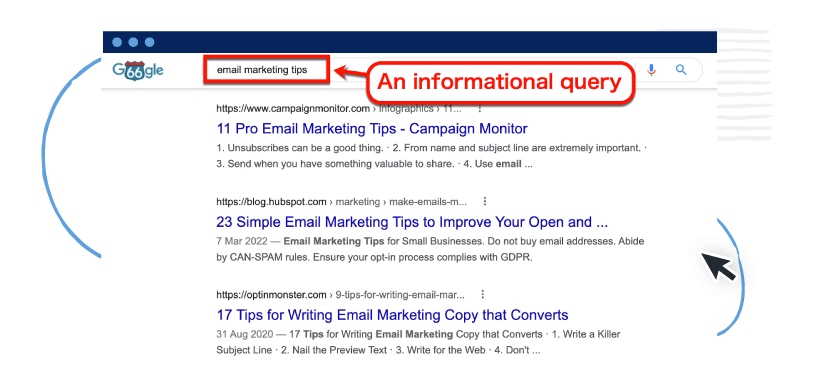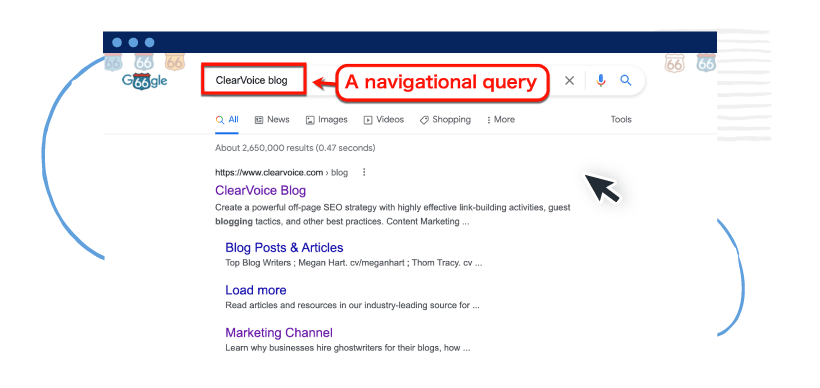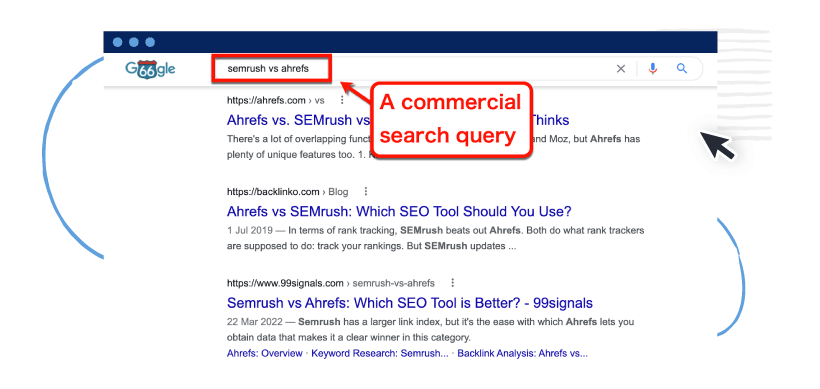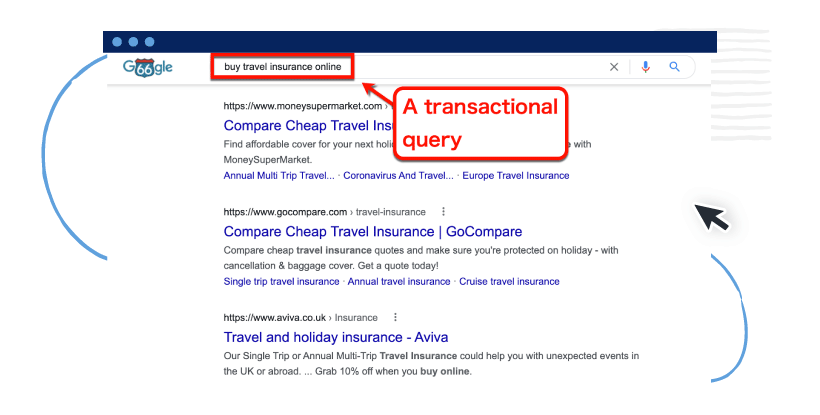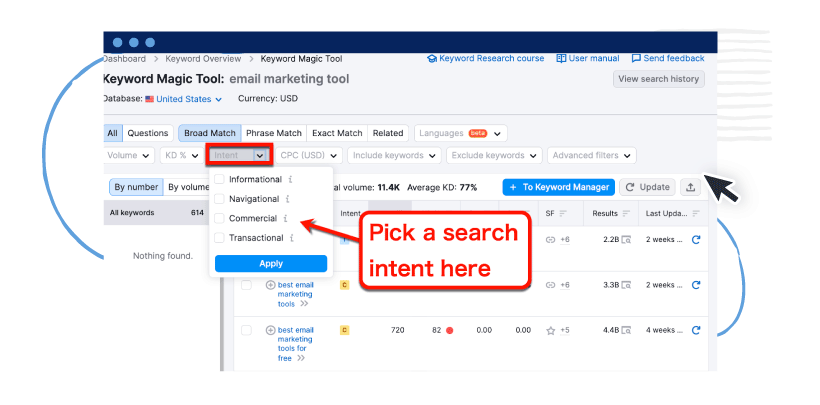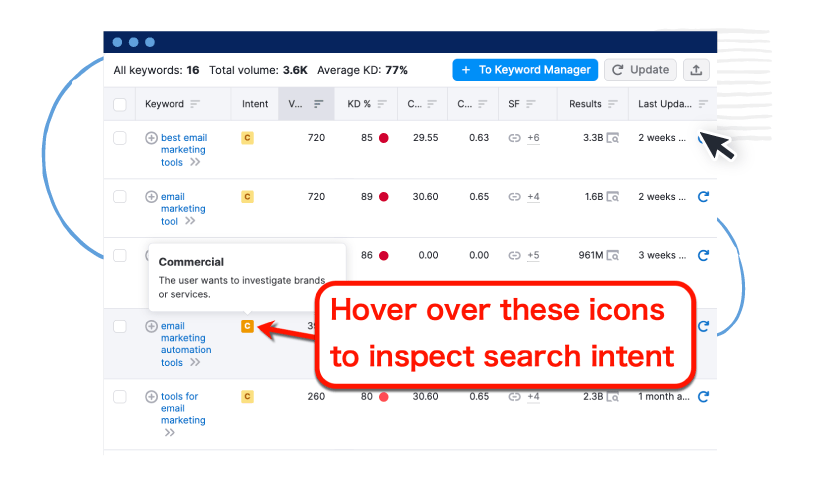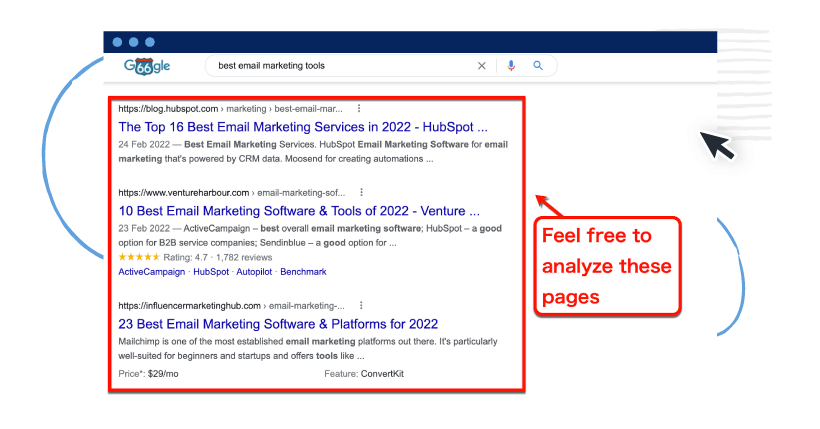Search intent is a crucial component of SEO that doesn’t get the attention it deserves.
Search intent pertains to the reason why a user searches the web.
By understanding search intent, marketers can create intent-based content that perfectly aligns with the audience’s short-term goals. Otherwise, there may be a mismatch between their expectations and the information provided by the content. And that’s something that happens way too often.
Here’s the bottom line: If you want your content marketing to generate results, you need to add search intent to the mix. To do that, you need to understand the four types of search intent.
Let’s begin.

4 types of keywords intentions
Online searches can all be distilled into four types of intent: informational, navigational, commercial, and transactional.
Here’s a quick rundown of these types, along with a few search intent examples:
1. Informational search intent
Informational search intent is when users search the web with the sole intention of learning. They’re not thinking of buying. They’re just looking for reliable and valuable information about a specific topic.
Informational queries are often straight-up questions that can be answered without having to buy or opt-in for something. They can be broad or very specific, like:
- Email marketing tips
- How does email automation work?
- What is email retargeting strategy?
This is what the search engine results page looks like with an informational query:
Image Source: Google.com
When someone uses queries with informational keywords, they’re not expecting sales pitches or product recommendations.
Sure, there’s a chance that they’ll go for a product recommendation out of impulse. But if you invest thousands of dollars in your content marketing strategy with the goal of generating sales, targeting users with informational intent isn’t ideal.
On the flip side, catering to these users is a great way to build your band’s authority and credibility. If you provide them with spot-on, informative content that meets their expectations, they might consider you as their go-to information source for that topic and may eventually buy your product later on.
Pro tip: Use the “people also ask” boxes to get more ideas for your content. This will help get you more aligned with users that are seeking information online.
2. Navigational search intent
A navigational search query is when the searchers intend to find a specific website.
Some examples of navigational searches are:
- ClearVoice blog
- ClearVoice freelancers
Plugging navigational queries in search engines will pull up these results:
Image Source: Google.com
In other words, the user only utilized the search engine as a navigation tool—hence, the name. Websites rank for navigational search keywords naturally simply by keeping their domain name.
3. Commercial search intent
As users inch closer to purchase readiness, they’ll begin to include commercial keywords in their search queries.
This brings us to commercial search intent, which is present in users who show interest in products or services.
Commercial searchers are usually shopping. They are on the fence about whether they should buy something. And to help with their research, they’ll use queries like:
- SEMrush vs Ahrefs
- What is the best email marketing tool?
- Canva review
- Grammarly alternatives
Here’s what a commercial search query pulls up from search engines:
Image Source: Google.com
Commercial search intent is one of the search intent types that can help brands generate paying customers.
If you want to target users with commercial intent, feel free to sprinkle “buy now” buttons, CTAs, and other conversion elements where they make sense. Just don’t make it your priority.
Rather, your main goal should be to fill the remaining knowledge gaps preventing users from committing to an action.
Put yourself in their shoes and think of questions like:
- Are there better alternatives out there?
- Is this product really worth the money?
- What do other customers think about this product?
- How can I tell if it’s the right solution to my problem?
4. Transactional search intent
At the bottom of the search intent funnel lies transactional search intent.
If users are ready to go beyond reading and actually do something, they have transactional search intent.
Transactional search intent can be identified with keywords that show a strong desire to buy, like “shop,” “buy,” or “order.” It’s also found in users who have pricing-related concerns in their queries, like “discount,” “pricing,” and “coupon code.”
Here are some examples:
- Buy travel insurance online
- White tuxedo for sale
- Ahrefs discount code
Image Source: Google.com
Targeting keywords with transactional search intent is an effective way to cash in on your SEO efforts.
After all, you won’t be doing SEO just to get organic traffic. You’re pulling in users who are ready to pull out their wallets and click the “buy now” button.
Whatever you do, don’t target keywords with transactional search intent without doubling down on conversion rate optimization.
It doesn’t matter if you attract boatloads of users in a buying mode. If you’re not looking at your click-through rate, page optimization, and the checkout experience, you’ll miss out on the profits to be made.
How to optimize for search intent
Knowing the different types of search intent can help you deliver engaging content experiences that will keep readers coming back for more. To get there you need to learn the steps on how to optimize content for a specific search intent.
1. Incorporate search intent in keyword research
If you use keyword research tools like SEMrush, you can pluck intent-based keywords from a long list of suggestions with ease.
The SEMrush Keyword Magic Tool comes with an “Intent” filter that sieves out keywords with the selected search intents.
Image Source: SEMrush.com
Select the intent you want to target and click on “Apply”. Within seconds, SEMrush will refresh the keywords list with suggestions that match the intents you specified.
To verify keyword intent, hover your mouse over the icons in the “Intent” column. A small pop-up should show to identify search intent.
Image Source: SEMrush.com
If your keyword research tool doesn’t have a similar feature, you can rely on their built-in keyword filters.
All you have to do is use the “Include” filter to look for keywords that contain specific terms.
- Informational: What, How, Why, Tips, etc.
- Navigational: Brand or product name
- Commercial: Review, Vs, Alternatives, Best, etc.
- Transactional: Pricing, For Sale, Order, Buy, etc.
2. Observe the top results
After identifying target keywords that match your target search intent, it’s time to develop content ideas.
A straightforward strategy is to analyze the top 10 search engine results for your target keyword.
Image Source: Google.com
Pay attention to content elements like the page title, subheaders, CTAs, and word count. In addition to helping you determine which subtopics to mention, it will also give you tangible targets for content production (what type of language or brand voice to use, how many words to write, etc.).
3. Take a look at rich snippets
Google allows certain websites to take center stage in search engine results through featured snippets. These are additional elements that can give users more context before even clicking on a site.
When properly configured, rich snippets give your content more “oomph” when appearing on search engine results.
Common examples of rich snippets are lists, star ratings, videos, and the Knowledge Graph.
Before you start writing see if any of your keyword searches yield a rich snippet and then plan to optimize for it accordingly.
4. Optimize your post from top to bottom
When creating an intent-driven post, don’t forget to add keywords to the right places. A general rule of thumb is to insert keywords at least once in the following content elements:
- Post title tag
- Headline
- Subheader
- Main content
- CTAs
Of course, you need to maintain the user’s search intent in mind as you write each section. Avoid going off-topic and minimize fluff that can derail readers from their journey.
Get perfect intent-driven content with ClearVoice
Analyzing search intent has its intricacies and it’s absolutely crucial to get it right if you want your content to produce tangible results for your business.
There is a lot that comes into creating content. It includes intensive research, optimization, making sure your intent aligns, and that your content answers the burning questions of your readers.
ClearVoice has a large network of vetted writers that help brands create high-performing content. Whether you’re looking to get better visibility, rankings, organic traffic, or even sales, we can help you.
Use the form below to learn how ClearVoice can make your content marketing initiatives a total breeze.
